This post may contain affiliate links. Please read our disclosure policy.
Italian Meringue Buttercream is silky, smooth, and airy. Use it to frost smooth, professional looking cakes or pipe on cupcakes! It is also a lot easier than it seems! I am here to give you all the professional techniques and troubleshooting tips to set you up for success!
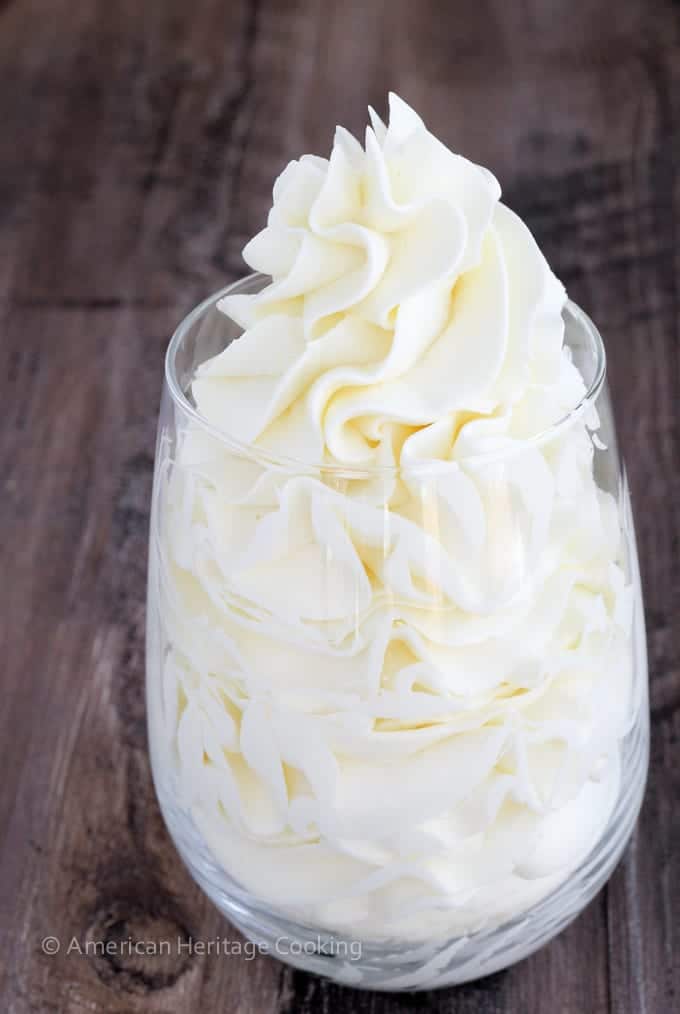
I love Italian Meringue Buttercream because it is light and airy but simultaneously rich and creamy. It is also magically stable and will keep for months in the freezer! So stable, in fact, if you think you totally messed it up, take heart, it’s probably totally fixable! I will give you all the troubleshooting advice below.
It is perfect for building professional layer cakes like I did in this layer cake assembly tutorial using this devil’s food cake or piping on cupcakes like these lemon coconut cupcakes.
Table of Contents
- Why you will love this Italian Meringue Buttercream:
- What is Italian Meringue Buttercream?
- How is Italian Meringue Buttercream different than other types?
- Professional Tips for Success:
- Ingredients Needed
- How do you flavor Italian Meringue Buttercream?
- How do you color Italian Meringue Buttercream?
- How to Make Italian Meringue Buttercream
- Chef Lindsey’s Recipe Tip
- How to refresh refrigerated Italian Meringue Buttercream?
- How to fix Italian Meringue Buttercream
- Storage
- Italian Meringue Buttercream Recipe
- Before You Go
Why you will love this Italian Meringue Buttercream:
- It is less sweet than American buttercream. If you don’t love the sweetness of frostings then you will love IMB. It is creamy and just the right amount of sweet.
- Versatile base: This of this recipe as your white canvas ready for your masterpiece! Add melted chocolate, salted caramel sauce, lemon curd, Nutella and anything else you can think of!
- Stability: Italian meringue buttercream is the most stable of the meringue buttercreams. It holds up to heat better than Swiss meringue, but it will still melt over 70 degrees F.
- Professionally tested: This is the buttercream that I used in my former life as an Executive Pastry Chef and currently use for custom cake orders. I have made it close to a thousand times. You can trust that it is going to work.


What is Italian Meringue Buttercream?
Italian meringue buttercream (IMB) seems complicated at first; it’s definitely the most sophisticated of its peers. Simply put, it is made by whipping egg whites to stiff peaks while simultaneously cooking sugar to the soft ball stage; you then slowly pour the sugar into the whipping egg whites; and, finally, add butter.
How is Italian Meringue Buttercream different than other types?
Italian Meringue Buttercream is made using an Italian meringue as the buttercream base as the name suggests. It has a lighter texture and taste than Swiss Meringue Buttercream and German; it doesn’t taste like pure butter like French Buttercream; and it isn’t as sweet as American Buttercream.
Professional Tips for Success:
- Go at your own speed. There is no rule that you have to whip the egg whites on high while you cook your sugar, so if they have reached stiff peaks and your sugar syrup is stubbornly stuck at 220˚F (been there), just turn down the mixer to low. Don’t stop that mixer! I didn’t say that! I said LOW.
- Pour your sugar in with the mixer on HIGH. Do you want scrambled eggs on your cupcakes? I didn’t think so. Turn that mixer up!
- Pour the sugar down the side of the bowl. Don’t hit the whisk because 235˚F syrup in the face is unpleasant. Don’t be that person. You will know if you did it right because there will be one little lava trail of cooled sugar down one side of the bowl.
- This sounds obvious but I’m going to say it anyways: cook your sugar to 235˚F. Soft ball syrup is a range. But, if you shoot for 235˚F, then by the time you get from the stove to the mixer, if the syrup has inched up a few degrees, no love has been lost. You will know if you overcook your sugar because there will be a pool of cooked sugar in the bottom of your mixer.
- When you start adding your butter, you want it to be soft but still a little cool. If it’s not totally soft enough, add it a little bit at a time and squeeze each piece before tossing it in. That’s right, squeeze your butter! It’s kinda fun. And kinda gross at the same time.
- If your buttercream gets soupy, switch from the paddle back to the whisk and beat it on high. All is not lost. Trust me. More tips below.
- If your buttercream breaks (looks curdled) when you start adding the butter, take heart, it will come together. Add the butter in little pieces and squeeze each one to soften it. If you have a kitchen torch you can torch the outside of the bowl with the mixer on high, but keep the torch moving! You want to warm the bowl not melt the buttercream.
Ingredients Needed
- Granulated Sugar: The granulated sugar in the meringue is here for stability as well as sweetness. The more sugar in the meringue, the more stable and the less volume.
- Water: Unlike when making a wet caramel the amount of water in a buttercream matters. In a caramel all the water will evaporate before caramelizing but that is not the case in an Italian meringue. Be sure to measure your water for the best results.
- Egg Whites: For the best results use separated egg whites. The stabilizers and foaming agents in liquid egg whites keep them from being as stable. They will curdle more easily when the syrup is added. Use the egg yolks to make lemon curd. Mix it into your buttercream for a fun lemon twist!
- Kosher salt: Kosher salt is optional but it will balance the sweetness slightly and also add stability to the meringue.
- Cream of tartar: Cream of tartar will also stabilize the meringue. It is optional but why not stack the deck in your favor.
- Unsalted butter: Use a good quality unsalted butter for the most stable buttercream. If you use salted butter, your buttercream will be salty! Eww.
How do you flavor Italian Meringue Buttercream?
- Lemon: You can use lemon extract (I only use Nielson Massey lemon extract), lemon paste (again only Nielson Massey lemon paste), lemon zest mixed with the sugar for the meringue, or lemon curd.
- Strawberry: Strawberry puree will break the buttercream. Use strawberry jam such as my strawberry jam without pectin, or dehydrated strawberry powder.
- Berries: For all other berries I prefer using jam.
- Peanut Butter: For this recipe as written, add ½ cup smooth peanut butter. You could also use chunky for texture, but I would add crushed salted peanuts as a garnish instead.
- Nutella: Add ½ cup Nutella or another chocolate hazelnut puree.
- Chocolate: Add 200 g (approximately 7 ounces) of melted and cooled chocolate to the finished buttercream. Use milk chocolate, semi-sweet or unsweetened to your taste.
- Vanilla: Add up to 2 tablespoons vanilla extract, 1 tablespoon vanilla bean paste or 2 split and scraped vanilla bean pods. Save the pods for vanilla bean anglaise or vanilla bean pastry cream!
How do you color Italian Meringue Buttercream?
You can use gel food colorings. You could also use natural colorings like dehydrated strawberries or beet powder.
How to Make Italian Meringue Buttercream
Prepare your ingredients:
Step 1: You want to make sure that you have everything measured out and ready to go. This step is critical. In the professional kitchen it is called mis-en-place. This recipe is simple but it does require seamless execution.
Step 2: Prepare your tools. Be sure that your mixing bowl is clean and free of any residual fat, or your meringue will not whip up and there will be sadness abound. You also want to make sure that your pot is clean. Dirty residue can cause the sugar to crystallize.
Prepare the Italian meringue:
Step 3: Mix half of the sugar with the water in a medium saucepan over medium heat, stir just until the sugar dissolves. When the pan heats up, brush around the sides of the pot with a clean pastry brush dipped in water to dissolve any sugar crystals adhered to the sides of the pot. You can also use a paper towel that you roll up or your clean finger in a pinch.
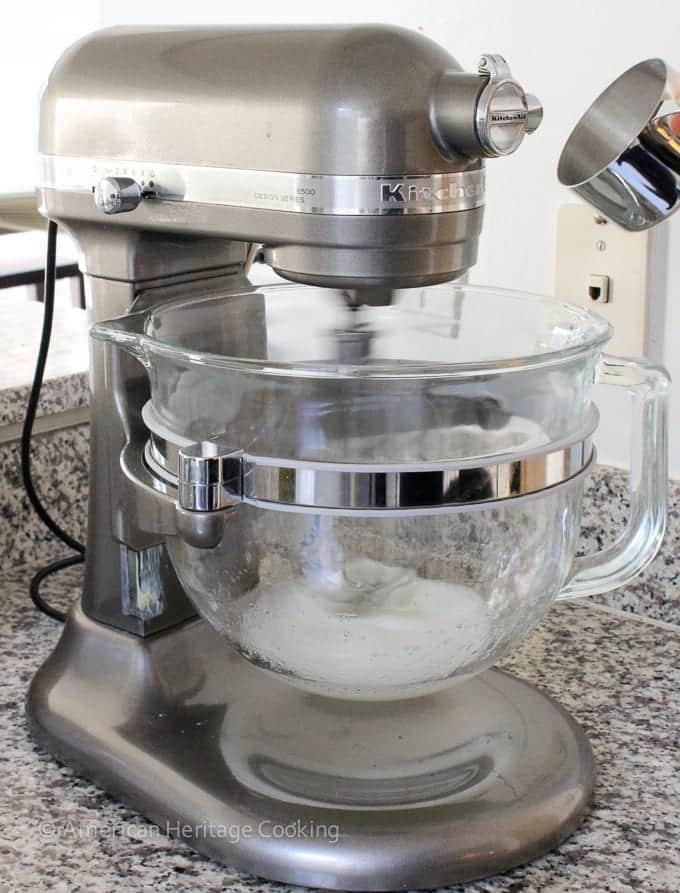
Step 4: When the sugar syrup starts to bubble begin whipping your egg whites in the bowl of a stand mixer fitted with the whisk attachment. You can add a pinch of salt and/or cream of tartar for stability if you wish. When your eggs begin to look frothy, slowly begin adding your reserved sugar, whipping constantly on medium-high.

Step 5: Continue whipping your egg whites until they form stiff peaks (photo 1 above). Ideally your meringue should reach stiff peaks at the same time that your sugar syrup reaches 235˚F.
If your egg whites are whipping too fast, reduce the mixer speed to medium or even low. You can also adjust the heat on the sugar syrup to make it cook faster or slower. Just be aware that turning the heat on the sugar syrup too low will cause it to crystallize. I know. It’s frustrating but we can do this!
Step 6: To test your syrup you can either use a candy thermometer or you can do it the old-fashioned way, which is what I did here. Take a tiny bit of the syrup on a spoon and dip it into ice water, reach in and grab the sugar. If it dissolves, it isn’t close to ready; if it forms a little malleable ball, it’s ready!! I don’t have a photo of this stage because if I had taken the time to snap a photo, my sugar would have over cooked.
Step 7: Turn your mixer up to high and SLOWLY pour the sugar syrup down the side of the bowl as in photo 2 above. Be very careful not to hit the whisk. Ideally you pour it in one solid stream down the edge because it will solidify where it hits the bowl, so if you pour it in three different places, you will be losing sugar. Sadness.
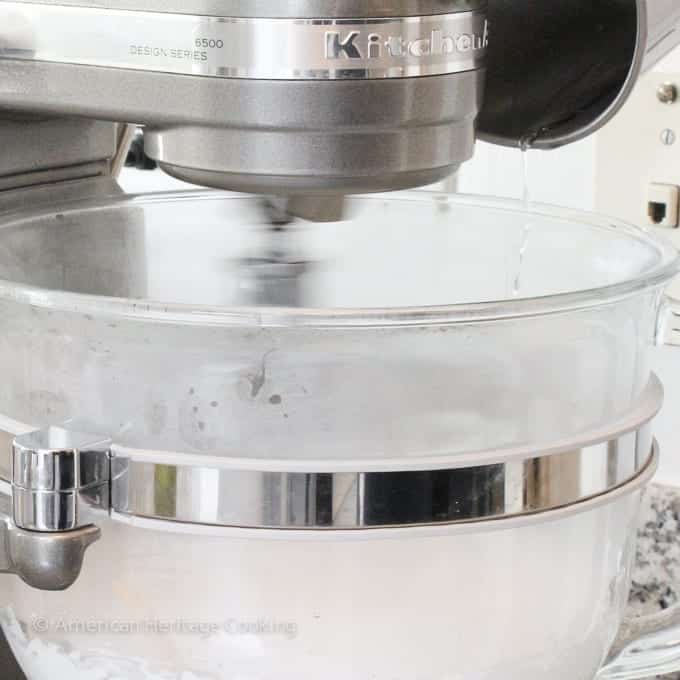
If you look closely at the above photo you can see where my sugar hit the side of the bowl. One little stream. No excess sugar lost. Go ahead, take a closer look…This is what perfection looks like. 😉
Finish the buttercream:
Step 8: Keep whipping the Italian meringue on high until it forms stiff peaks like in the first photo below, but what is more important than the stiffness of the meringue is the temperature of the meringue. Before you begin adding the butter, the bottom of the bowl should feel barely warm (picture 2).
There is so much sugar in this meringue that it will not over-whip before it cools appropriately. Even though my meringue had reached stiff peaks in photo 1, I still needed to whip it another few minutes for it too cool.
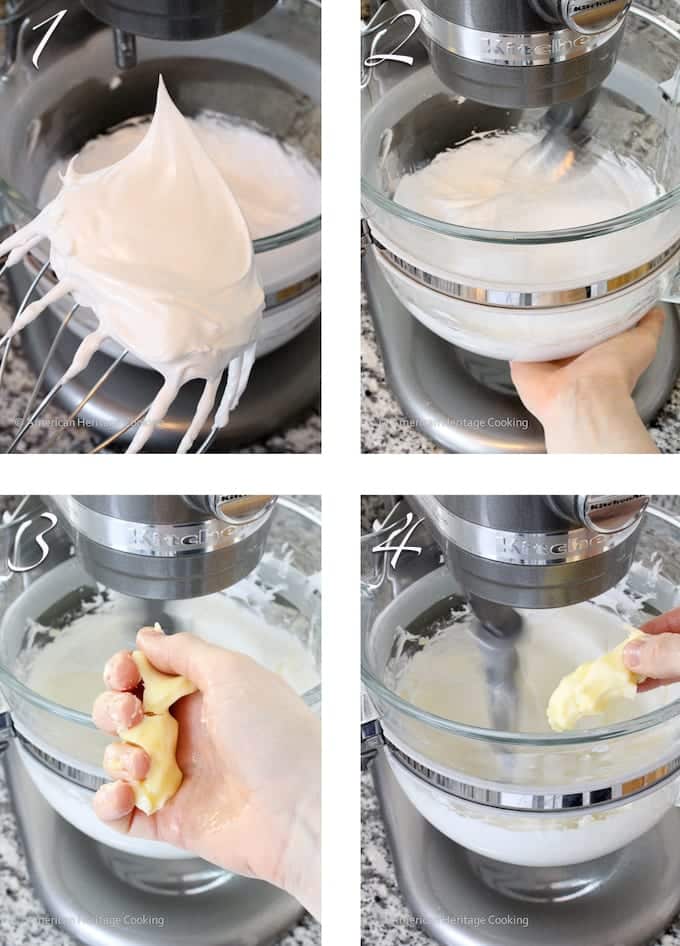
Step 9: When the bowl feels just slightly warm, switch to the paddle attachment and begin adding your butter a piece at a time like in picture 3. I take my butter out of the fridge when I begin measuring my ingredients. Before adding each piece squeeze the butter. I do this to finish warming it and to make sure it is the right temperature. It isn’t necessary. In full disclosure, I stopped doing this years ago as my comfort level grew.

Step 10: Continue to beat the butter in on medium-high until the buttercream is smooth and there are no remaining pieces of butter. The buttercream in photo 1 above is still a bit lumpy. Not there yet!!! Photo 2 is smooth and creamy. At this stage I switch back to the whisk, add any desired flavorings and beat it until it is light and fluffy. You are now ready to frost!
Step 11: Add any flavorings such as extracts, lemon curd, salted caramel sauce, melted chocolate, jam or nut pastes.
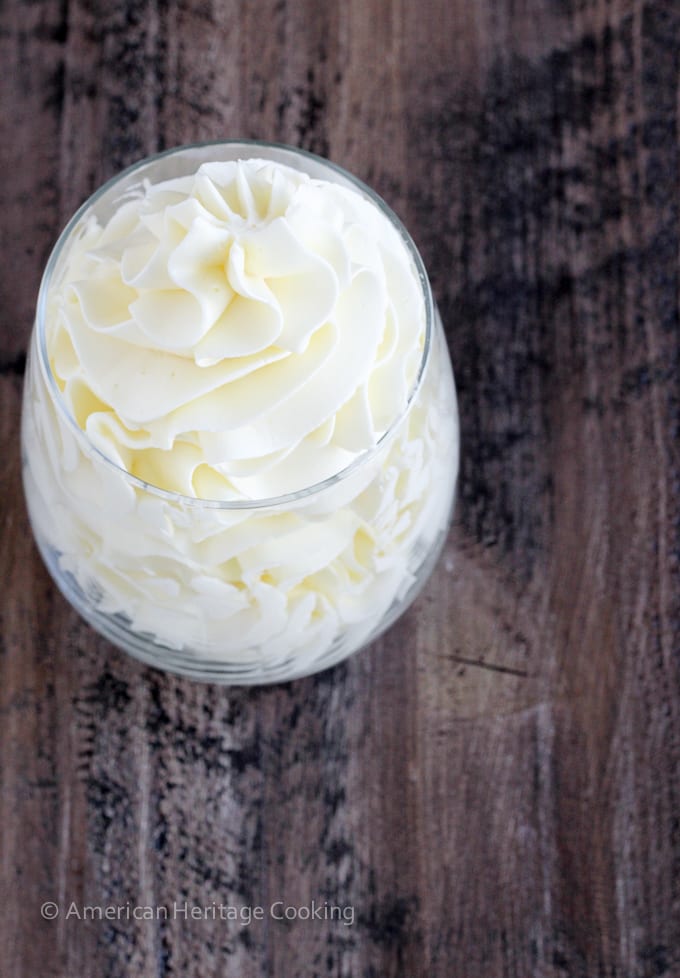
Chef Lindsey’s Recipe Tip
The biggest take-away here is that you are in control! You control the heat of your sugar and how quickly it cooks; you control the speed at which your egg whites whip; and you control the temperature delta of your butter and meringue. If one is getting away from you, adjust and keep going!
How to refresh refrigerated Italian Meringue Buttercream?
- To refresh refrigerated buttercream: Throw it in the mixer and beat with the paddle attachment until smooth; then switch to the whisk to whip it up until light and fluffy.
- To refresh frozen buttercream: Thaw in the refrigerator overnight, let warm slightly at room temperature and then proceed with the refreshing refrigerated buttercream instructions above.
- Speed it up! You can speed up the refreshing process by warming the bowl over a gas stovetop flame or with the kitchen torch. Just be careful because you don’t want to melt your buttercream.
How to fix Italian Meringue Buttercream
It will look curdled if it is too cold. This is most common when trying to refresh or rewhip cold buttercream. The easiest way to fix it is to gently heat the bowl with a kitchen torch while beating it with the paddle attachment. Keep the torch moving so you don’t melt the butter. You can also just let it mix on medium-low speed with the paddle attachment until it warms itself up enough and comes together.
It is soupy if it is too warm. The meringue was too warm for the temperature of the butter that you added. You can add slightly cold butter to warm meringue but adding perfectly room temperature butter to warm meringue will lead to soup. To fix the soupy buttercream, place the bowl, buttercream and mixer attachment in the refrigerator. Chill 30 minutes to 2 hours depending on how warm it is. Continue to mix on medium speed until it comes together. As a last resort when you have tried everything else, just keep mixing it on medium with the paddle attachment. Go do something else and come back. Sometimes, just sometimes, all she needed was time to get herself together. And I think we can all feel that.
Sadly the butter was too cold when it was added to the buttercream. You can try to fix this by gently warming the entire bowl with a kitchen torch while beating the buttercream with the paddle attachment. Most likely in order to get rid of the lumps you will have to make the whole buttercream too warm to use. Pop it in the refrigerator and then beat it again with the paddle attachment once cool. Alternatively, you could just use it with some butter pieces because continuing to heat it you run the risk of melting all your butter and ruining your buttercream. Cover the cake in sprinkles and no one will notice. And that is my professional opinion.
Unfortunately this is the one mistake that you cannot come back from. If you start adding the butter and you see it melt in the meringue, stop adding butter. Keep beating and allow the meringue to cool before continuing to add more butter. A little melted butter is okay; all the butter melted is ruined.
Storage
Store Italian Meringue Buttercream at room temperature for 2-3 days or refrigerated for 2 weeks. It can also be frozen for 3 months. Before using, mix cold buttercream in the bowl of a stand mixer fitted with the paddle attachment on medium until it comes together. It will look curdled first. Don’t stress, just keep mixing!
If you tried this recipe and loved it please leave a 🌟 star rating and let me know how it goes in the comments below. I love hearing from you; your comments make my day!
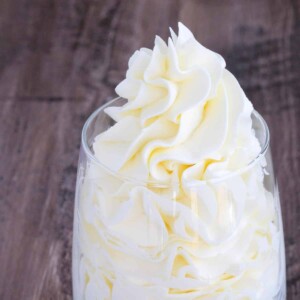
Italian Meringue Buttercream
Ingredients
- 2 cups sugar divided
- ⅔ cup water
- 5 large egg whites
- pinch kosher salt optional
- pinch cream of tartar optional
- 2 cups unsalted butter cubed (4 sticks or 1 pound), cool but not cold
- 2 teaspoons vanilla extract
Instructions
- You want to make sure that you have everything measured out and ready to go. This recipe is simple but it does require seamless execution. You also want to make sure that your mixing bowl is clean and free of any residual fat, or your meringue will not whip up and there will be sadness abound.
- Mix half of the sugar with the water in a medium saucepan over medium heat, stir just until the sugar dissolves. When the pan heats up, brush around the sides of the pot with a clean pastry brush dipped in water to dissolve any sugar crystals adhered to the sides of the pot. You can also use a paper towel that you roll up (I did because I forgot my brush at school.)
- When your sugar starts to bubble begin whipping your egg whites in the bowl of a stand mixer fitted with the whisk attachment. You can add a pinch of salt and/or cream of tartar for stability if you wish. I only used salt in the photos you see. When your eggs begin to look frothy, slowly begin adding your reserved sugar, whipping constantly on medium-high.
- Continue whipping your egg whites until they form stiff peaks. Ideally your meringue should reach stiff peaks at the same time that your sugar syrup reaches 235˚F. If your egg whites are whipping too fast, reduce the mixer speed to medium. You can also adjust the heat on the sugar syrup to make it cook faster or slower.
- To test your syrup you can either use a candy thermometer or you can do it the old-fashioned way, which is what I did here. Take a tiny bit of the syrup on a spoon and dip it into ice water, reach in and grab the sugar. If it dissolves, it isn’t close to ready; if it forms a little malleable ball, it’s ready!
- Turn your mixer up to high and SLOWLY pour the sugar syrup down the side of the bowl. Be very careful not to hit the whisk. Ideally you should pour it in one solid stream down the edge because it will solidify where it hits the bowl, so if you pour it in three different places, you will be losing sugar. Sadness.
- Keep whipping the Italian meringue on high until it forms stiff, but what is more important than the stiffness of the meringue is the temperature of the meringue. Before you begin adding the butter, the bottom of the bowl should feel barely warm.
- When the bowl feels just slightly warm, switch to the paddle attachment and begin adding your butter a piece at a time. I take my butter out of the fridge when I begin measuring my ingredients. Before adding each piece squeeze the butter.
- Continue to beat the butter in on medium-high until the buttercream is smooth and there are no remaining pieces of butter. Add the vanilla extract or other flavorings. At this stage I switch back to the whisk and beat it until it is light and fluffy. Pipe or spread as desired!
Video
Notes
Nutrition
Before You Go
I hope you enjoyed this professional chef tested recipe. Check out our other delicious, chef-developed cake frosting recipes!
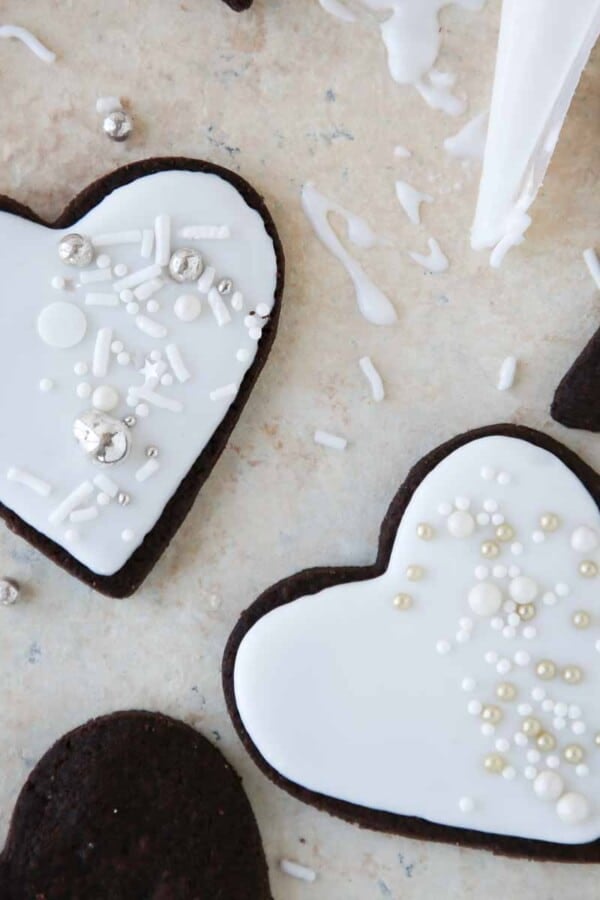


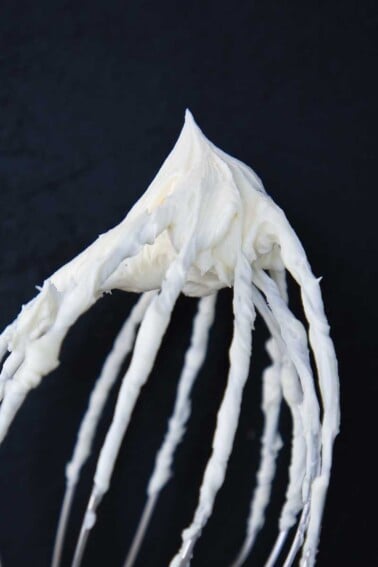








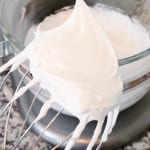
Yes I’m sure! I hope I can post a pic of my mixer here. It is a Kenwood Classic Major KM630. Thank you for your reply. I think I need to buy the stainless steel bowl for this model of kenwood mixer.
Hi Zunun! I just googled the model and I see the plastic bowl. If there is a metal option that would definitely be worth the investment so that you can make meringues, this buttercream, marshmallows (!), egg foam based cakes like this one for example, etc. Egg whites also whip up better in metal and the metal will last forever! Anyways. Happy baking!
Hi Lindsey, I recently bought a kenwood major stand mixer but the bowl is not glass bowl or stainless steel bowl. It’s a plastic bowl! And i think hot sugar syrup will surely melt my bowl, don’t you think? And is it okay if i make it using hand mixer instead?
Hi Zunun! I would not make this in a plastic bowl for several reasons. The first is that unless you are absolutely positive the plastic is heat resistant over 400 degrees, it might melt as you can imagine. The second is that, even if the plastic is rated over 400 degrees, it is very hard to clean all the oil out of a plastic bowl over time, which means your meringue may be flat. I just looked on kenwood’s site and I didn’t see a stand mixer with a plastic bowl. Are you sure? You can certainly try to make this with a hand blender, but I would make sure you have a deep glass or metal bowl and you have someone pour it while another person uses the hand mixer. You want to be especially careful that the hot syrup doesn’t hit the whisk and splatter sugar all over you and your friend. Maybe you are incredibly strong but I would get too tired making this recipe with a hand blender. You have to make the meringue, then operate the blender on high speed while pouring the hot syrup then you have to beat it until it cools and then you have to continue to beat it to add the butter. All in all it sounds like a bad idea but the French used to make this by hand before there were hand and stand mixers, so if the French can do it… 😉
Hello great recipe! I was wondering instead of using the Semi-Sweet Chocolate could i use a Peanut Butter Chip instead? Thanks!
Hi Vanessa! You could certainly try or you could try melting peanut butter that way you can use less and get a more intense pb flavor.
oh great idea on the Melted Peanut butter!! More Flavor i bet. Thanks again! 😀
No problem! Just make sure it isn’t too hot or it will melt the butter and break your buttercream! (same goes for the chocolate or pb chips)
yup worked better then i thought!! i used Melted Peanut Butter!
Woohoo!!! Thanks for reporting back! I just filmed a video tutorial for this and made a chocolate one…but I feel like my next creation needs to have a chocolate AND a peanut butter buttercream. Back to the kitchen!
Yes i Agree Everyone Loved the Peanut Butter Buttercream! 😛 Thanks for the Video`s! i use This Buttercream a Few Times a Month! in love!
I made this but I think I killed the meringue 🙁
Is there anyway to fix it?
Hahah. Sadness. I’ve been there. Can you be more specific? Did it break? Is it soupy? Is the butter not incorporating?
I was adding the sugar syrup and it turned into liquid! I want to do it again but i’m afraid the same thing will happen 🙁
Hi Andrea, The hot syrup deflates the meringue almost completely which is normal. Make sure you pour in the sugar slowly with the whisk attachment on high speed then continue to beat with the whisk attachment on high until it is just warm to the touch. What did you do after you added the sugar?
Hello Lindsay, it happened to me that adding the butter at the beginning everything was perfect but when I added the las 100 grams piece by piece the butter cream changed its color to butter yellow and it looked very buttery, should I change the quantity of the butter? Or is it ok?
Hi leonardo, everything is fine. If you whip it up properly, then it will return to white.
A million thanks to you for the recipe and tutorial. First time ever making it, followed all of your instructions to a tee and have perfect buttercream with the best consistency and flavor I have ever experienced!! I am so glad that I crumb coat the cakes because it means I get to eat the bit with the crumbs in it!!
Yay!!! I’m so glad you liked it Joann! And aren’t the crumbcoat leftovers the best?! I also level my layer cakes so I have a little bit of extra cake to eat with the crumb-coat frosting too 🙂
Here is what I made!! First time for everything! https://morethan2016.wordpress.com/2016/04/15/an-epic-cake-adventure/
I took a look yesterday! It’s amazing! Well done!
Thank you! 🙂
This is my go to Italian Buttercream! I wanted to try this because I can’t stand regular buttercream because it’s so sweet and french buttercream was too heavy for my liking. Makes me feel like a serious baker showing up to parties with cakes and cupcakes slathered in this stuff. My husband swears he could eat it for dinner or any meal for that matter and my mom who is not a huge sweets fan goes nuts over it. The directions are spot on, and I can now say I can make this without the directions (minus measurements). I’ve made this recipe now at least 3 times and people go CRAZY for it. Thank you so much for sharing and I can’t wait to try some more of your recipes.
Thank you so much, Mallory! Your comment made my day! I feel exactly the same way about Italian Meringue Buttercream – makes me feel extra fancy! I am super impressed that you can make it without the directions! Happy baking!
Hi, just wondering is it safe to eat? I used to hear that people said it is okay to eat this buttercream since the sugar syrup practically kill all the bacteria in the egg but some people said that the temperature didn’t reach the require temperature for the egg to be fully cooked. So now I was confused:(
People said swiss meringue buttercream is safer but i know that swiss meringue is not as stable as italian and i need the most stable buttercream because the weather here is extremely hot sometimes! Really glad if you can clear this! Anyway your tutorial is amazing!
Please see my above comment about the safety of this buttercream. You should also know that every traditionally trained baker in the world uses Italian or Swiss buttercream. If you have concerns, use pasteurized egg whites. But just know they behave differently than fresh ones.
Hi! do i use unsalted butter in this recipe? i am assuming so!
Hi Tanya, Yes! I use unsalted butter in everything because that way you can control the salt.